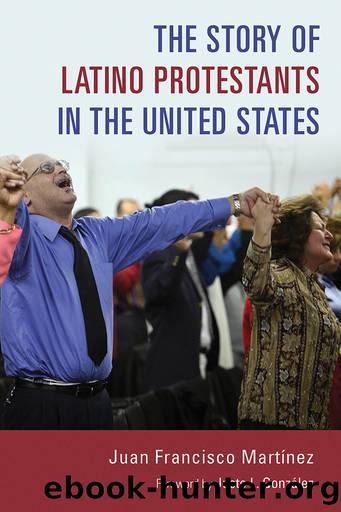The Story of Latino Protestants in the United States by Martinez Juan Francisco;

Author:Martinez, Juan Francisco;
Language: eng
Format: epub
Publisher: Eerdmans
These were added to the two districts that already existed, the Puerto Rico District (started in 1921) and the Eastern Hispanic District (started in 1957). In 1981 the Southeastern Latin American District was established for churches in Florida, North Carolina, South Carolina, Georgia, Alabama, and Mississippi. Later (1998) the Pacific Latin American District was divided in two, with churches in Washington, Oregon, and central and northern California forming the Northern Pacific Latin American District.
This structural expansion reflected the growth of the Latino churches. In 1977 there were 481 churches and 36,000 members. The growth experienced during this period would set the stage for more explosive growth and expanded impact in the latter part of the twentieth century. In a sense, the stage was set for that new role in 1984 when Jesse Miranda was named superintendent of the Pacific Latin American District (more in the next chapter).7
The Southern Baptists saw a similar growth pattern, reporting faster growth during this period than the AG. The most dramatic growth happened in Texas, but they established Latino churches in most of the areas where Southern Baptists and Latinas interacted. By 1980 Joshua Grijalva reported that there were 115,000 Hispanic Baptists in the United States (40,000 in Texas) and that the Southern Baptists had 1,600 churches, 600 of which were in Texas.8
The Mexican Baptist Convention of Texas had merged with the Baptist General Convention of Texas in 1964. This made it possible to coordinate Baptist ministries among Latinos in the state. Anglo Baptists in Texas and throughout the United States were very willing to provide funding for evangelization and church development among Latinos. The Southern Baptist model for developing and funding ministry fell somewhere between those of the AG and the historic denominations. New ministries were provided a fair amount of funding, but local ministries were granted significant autonomy. This provided extensive opportunities for ministry expansion, though it also created situations where Latino churches received outside funding for many years.9 But the sense among Baptists at that time was that
Unification has been tried and proven. It is Godâs answer to the needs of the teeming thousands of Hispanics. The problems are many but the promises of God are greater when his people attempt great things for Christ. Some of the problems are: educational opportunities for Hispanic children, fairness and equality in job seeking, continued prejudice on the part of many, the continued flood of undocumented people into the state, etc. . . . [But] unification does not mean decentralization or loss of identification. . . . The ministry may have to be monolingual or bilingual. And there may be those who will completely blend into the American culture and society. But we can all work together for Jesusâ sake.10
The Seventh-Day Adventists experienced a growth pattern similar to that of other groups. They were establishing Latino churches in each of their districts (unions), expanding into new parts of the United States as Latinas moved into those areas. By 1980 they were reporting 28,400 Latino members in the United States.
Download
This site does not store any files on its server. We only index and link to content provided by other sites. Please contact the content providers to delete copyright contents if any and email us, we'll remove relevant links or contents immediately.
| Church Administration | Church Growth |
| Church History | Church Institutions & Organizations |
| Church Leadership | Church Materials |
| Clergy | Ecclesiology |
| Ministry to the Sick & Bereaved | Pastoral Resources |
Fangirl by Rainbow Rowell(8807)
How to Bang a Billionaire by Alexis Hall(7941)
Wonder by R. J. Palacio(7749)
The Space Between by Michelle L. Teichman(6587)
The Thirst by Nesbo Jo(6450)
Assassin’s Fate by Robin Hobb(5867)
Wiseguy by Nicholas Pileggi(5333)
The Night Circus by Erin Morgenstern(5041)
The Kite Runner by Khaled Hosseini(4960)
Paper Towns by Green John(4811)
Bittersweet (True North #1) by Sarina Bowen(4719)
Gerald's Game by Stephen King(4385)
Too Much and Not the Mood by Durga Chew-Bose(4103)
Pillow Thoughts by Courtney Peppernell(4031)
Goodbye Paradise(3460)
Twelve Days of Christmas by Debbie Macomber(3421)
Good by S. Walden(3360)
The Rosie Effect by Graeme Simsion(3223)
The Cellar by Natasha Preston(3079)
